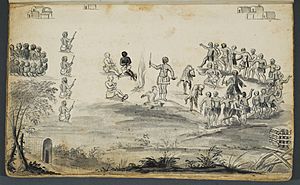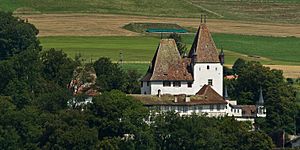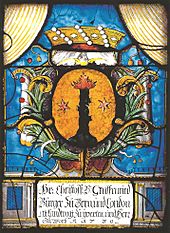Christoph von Graffenried, 1st Baron of Bernberg facts for kids
Quick facts for kids
Christoph von Graffenried
|
|
|---|---|
| Baron of Bernberg | |
| Predecessor | New creation |
| Successor | Anton Tscharner de Graffenried, 2nd Baron of Bernberg |
| Born | 15 November 1661 Worb Castle, Bern, Switzerland |
| Died | 1743 (aged 82) |
| Spouse(s) |
Regina Tscharner
(m. 1684) |
| Father | Anton von Graffenried, Lord of Worb |
| Mother | Catherine von Graffenried |
Christoph von Graffenried (born November 15, 1661 – died 1743) was an important person from Switzerland. He came from a noble family. He is famous for starting the town of New Bern, North Carolina in America. He was also a land investor and a leader in the early days of Swiss and German settlement in America. We know a lot about his life from his own book, Relation of My American Project, which he wrote around 1716. In this book, he shared his experiences as the Baron of Bernberg and a Landgrave of Carolina.
Early Life and Family
Christoph von Graffenried was born on November 15, 1661. His birthplace was Worb village, near Bern, Switzerland. His father, Anton von Graffenried, was the lord of Worb. Christoph went to universities in Heidelberg and Leyden to study. Around 1680, he visited England. There, he met important people like John Colleton. These people were "Lords Proprietors" of Carolina, meaning they owned land there.
In 1683, Christoph returned home. On April 25, 1684, he married Regina Tscharner. They had thirteen children together.
Starting the New Bern Colony
As Christoph's family grew, his job as a government official and his family's land didn't bring in enough money. He started to have many debts. Around 1708, he met Franz Ludwig Michel, an explorer. Michel convinced him to join a plan to find silver in America. They also wanted to start a colony for Swiss people who were poor or facing religious problems.
In 1709, Von Graffenried met his old contacts in England. The Lords Proprietors of Carolina gave the Swiss group 19,000 acres of land. This land was along the Neuse and Trent rivers in Carolina. Von Graffenried also bought 5,000 acres himself. Because he owned so much land, he was given special titles. He became a "Landgrave of Carolina" and later the "Baron of Bernburg." Also, Queen Anne gave £4,000. This money helped pay for 100 German families to travel to America. These families were called "German Palatines." They had fled to England because of a war.
In January 1710, Von Graffenried sent 650 Palatine settlers to Carolina. They were led by John Lawson. Lawson was a surveyor who knew the area well. He promised to guide the settlers to the best places for their new homes. Their trip was very difficult. They faced many winter storms. It took them thirteen weeks to reach Virginia. Then they traveled overland to Carolina. Many people got sick, and about half of the 650 colonists died before they reached their destination.
In July, Von Graffenried sailed with about 150 Swiss colonists. Their journey was much smoother. They landed in Virginia in September. He then met Michel and Lawson in the Neuse-Trent area. He quickly planned out a new town where the Trent and Neuse Rivers met. He named it New Bern. A local Native American tribe said the land belonged to them. So, Von Graffenried talked with them and bought the land for the new town. The skilled workers in the group stayed in the town. The farmers were given 250-acre plots of land further up the Trent River.
Even with a quick start, the colonists badly needed food and other supplies. The deputy governor of North Carolina was supposed to provide money for these things. But there was a big political argument in the Carolina government. This meant no money came. Von Graffenried asked the Lords Proprietors, other investors, and the local government for help, but he didn't get any. In the summer of 1711, many settlers got sick with yellow fever. Several died, including two Swiss helpers in Von Graffenried's own home.

At the same time, the relationship between the colonists and the Native Americans in the area got worse. The Native Americans were upset because Europeans were taking more and more of their land. They also felt cheated in their trading deals with the settlers. Von Graffenried's new colony was not specifically targeted. He later said that he always treated the Native Americans fairly.
Von Graffenried didn't seem to know how bad things had become with the Tuscarora tribe. In September 1711, he and John Lawson started a trip up the Neuse River. They hoped to find a new trade route to Virginia. The trip was planned for about two weeks. They brought two Black servants and two Native American guides. Their path went right through the heart of Tuscarora land. The Tuscarora captured Von Graffenried, Lawson, and their Black servants. Von Graffenried and Lawson went through a long series of trials. Finally, the Tuscarora decided they were both guilty of crimes against their people and should be killed. Von Graffenried defended himself. He said he had not been part of any fights with the Native Americans. He also said he was protected by the Queen of England, who would surely get revenge if he died. In the end, the Tuscarora let Von Graffenried go but killed Lawson. We don't know exactly how Lawson died.
The Lieutenant Governor of Virginia, Alexander Spotswood, helped Von Graffenried. He talked with the Native American tribes on Virginia's border and demanded Von Graffenried's release. Von Graffenried was freed after six weeks of being held captive. When he finally reached New Bern, he found it empty and burned. On September 22, 1711, while Graffenried was captive, the Tuscarora and their friends had attacked white settlers in the area. This conflict became known as the Tuscarora War. Sixty Swiss and Palatine settlers in New Bern and nearby areas were killed. Fifteen were taken captive. The people who survived ran away from New Bern. They found safety at a fort built by a plantation owner named William Brice.
The colonists were surprised to see that Graffenried was still alive. But they had lost trust in his leadership. He never fully got back his authority. He refused to seek revenge for the Native American attacks, which made some settlers angry. Some settlers followed him back to New Bern. But others stayed at the Brice plantation. A disagreement over some tools almost caused a fight between the groups. The unhappy colonists complained to the government. Graffenried had to go before the assembly to explain his actions.
During the winter of 1711–1712, Graffenried and the settlers who were still loyal to him stayed inside New Bern. They planned to move their settlement to Virginia. When supplies ran low, Graffenried went to Albemarle County. He got a ship full of corn, gunpowder, and other supplies. Sadly, the ship caught fire on the way back to New Bern, and all the supplies were lost. In the spring of 1712, Graffenried traveled to Virginia. He wanted to find a new place for a settlement near the Potomac River. Before leaving, he arranged for Franz Michel to take any willing colonists to Virginia by ship.
In Virginia, the baron hired a guide named Martin Chartier. Besides finding a good place for a settlement, Graffenried really wanted to find silver. People said there was silver in the area. Chartier took him to Sugarloaf Mountain and then to the Shenandoah Valley. They visited Massanutten Mountain, where people thought silver mines were located. Graffenried hoped finding silver would fix his money problems. However, they found no silver.
It became clear that Michel would not be transporting any colonists. Michel later said his ship was not safe to sail. So, Graffenried decided to go back to North Carolina. On his way back, he stopped to talk with Governor Edward Hyde. At that time, many people were getting sick with yellow fever in the area. The disease hit the governor's home. Graffenried also got sick but got better. The governor, however, was not so lucky and died.
Graffenried tried for a while longer to find a way to restart his colony. But his investors no longer trusted him. People he owed money to were threatening to have him arrested and put in jail for debt. On Easter in 1713, he sailed for England. Before he left, he put all the company's land up as a mortgage to Thomas Pollock. He returned to Switzerland in 1714.
Later Life and Legacy
Late in 1714, Graffenried returned to Worb. He had lost all his money and was very sad. It took him several days to face his father. His father had always been critical of his efforts. Perhaps to defend himself, Graffenried soon wrote a book called Relation of My American Project. It told all about his adventures in America. He wrote at least three versions of it.
In 1731, Christoph's father, Anton von Graffenried, gave Christoph the job of managing the family estate. Anton kept the income from the estate for himself. Managing the estate didn't make much money. But his father thought he had been very generous to his son, who spent money quickly. Later, when Anton became Mayor of Murton, he needed someone to represent him in Iverton. Christoph didn't really want the job. But to please his wife, he ran for it and was elected. In 1730, when Anton died, Christoph fully inherited the Worb estate. He kept it until 1740, when he gave it to his sons. Three years later, in 1743, Graffenried died. He was buried in the church at Worb.
Christoph's son, also named Christoph, moved to America. He married Barbara Tempest Needham from England. Their children started the American branch of the family. They used the French version of the name, De Graffenried. This family became well-known in both Virginia and Tennessee.
Selected Works
- Relation of My American Project (c. 1716)



